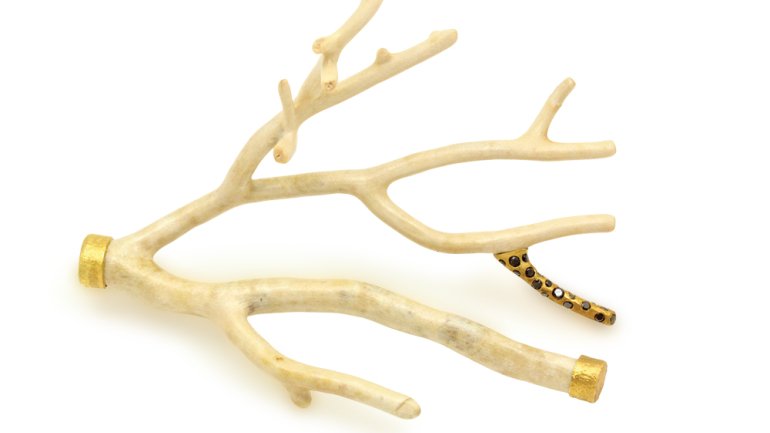Golden Age
Golden Age
This perception-shifting kimono by John Cederquist (which doubles as a functional cabinet) channels the power of graphic images to sway emotions. The title, Big Kanji, refers to the Japanese characters on the kimono, which mean “Heavenly victory” – itself the name of the series of kimonos Cederquist made several years ago, as part of a response to the war in Iraq. The words are a sort of “rallying cry,” says the Southern California artist, whose work is inspired by historical kimonos painted with World War II propaganda.
In the midst of an extreme multiyear drought, Australian artist Inari Kiuru began imagining how climate change might affect the far future. Drought (2008) is a wedding gift improvised from materials including found ob-jects, fine silver, and gold, to be given – as Kiuru puts it – in a time when resource shortages drastically shift traditional notions of ceremonial and celebratory items.
Yeesookyung, based in Seoul, South Korea, pieces together vases from the discard piles of master ceramists. This 2007 piece from her Translated Vases series prominently features 24-karat gold, which not only marries disparate pieces of pottery, but also adds depth and makes for poignant commentary on the nature of imperfection.
“Minimalist” and “restrained” aren’t always the most popular adjectives to describe statement jewelry made with precious materials. Yet both characterize the 2011 Shiro brooch, created by April Higashi. In her piece, the Bay Area artist re-imagines the “wild and imperfect” beauty of nature, incorporating gold inset with black diamonds into a branch of fossilized coral.
Monika Knutsson explores the glamour of 20th-century fashion, hand-sewing vintage lace to create rings, brooches, and necklaces, then dipping the work in 24-karat gold. The New York-based Knutsson names each of her works after a different early Broadway actress; this one, a limited edition from 2010, is called Tallulah. Her work has found favor with another golden girl, Beyoncé.
Factories and workshops alike told Shanghai artist Zhang Zhoujie that his designs for metal furniture, such as 2014’s Split Chair, were technically impossible; un-daunted, the designer started his own workshop. His focus is now dedicated to handcrafting futuristic chairs, tables, and “digital vessels” – vases, platters, and other homewares based exclusively on computer-generated designs.
Adrian Saxe’s ceramics often skewer viewers’ sense of tradition by mixing humor and pop culture references with historical ceramic forms. The Los Angeles artist topped his vessel Untitled Ewer (Twister with Apatite II) (2004-10) with a football player clutching a box-shaped crystal. Saxe views it as a cheeky play on words: As he puts it, the player has an “apatite” for victory.

